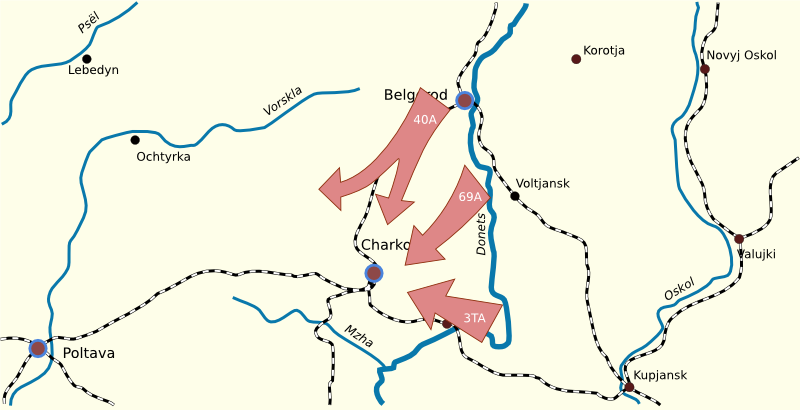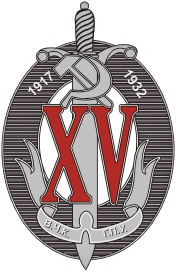|
Filipp Rudkin
Filipp Nikitovich Rudkin (; 27 November 1893 12 October 1954) was a Belarusian Soviet Army major general and a Hero of the Soviet Union. After fighting in World War I, he successively became a Cheka, OGPU, and NKVD officer, seeing action in the Russian Civil War. Rudkin was transferred to the reserve in 1938 but reinstated two years later. After the Operation Barbarossa, the German invasion of the Soviet Union, began on 22 June 1941, he became an armor officer in the Red Army. Given command of a separate tank brigade, Rudkin led it in the Ostrogozhsk–Rossosh Offensive, Operation Star, and the Third Battle of Kharkov in early 1943. For his leadership he received the title Hero of the Soviet Union in March, and became commander of the 15th Tank Corps in June. After leading the unit in Operation Kutuzov, he was considered unsuited for corps command and relieved, being demoted to command a rear area tank training unit. Rudkin was sent back to the front in January 1944, and led the ... [...More Info...] [...Related Items...] OR: [Wikipedia] [Google] [Baidu] |
World War II
World War II or the Second World War, often abbreviated as WWII or WW2, was a world war that lasted from 1939 to 1945. It involved the vast majority of the world's countries—including all of the great powers—forming two opposing military alliances: the Allies and the Axis powers. World War II was a total war that directly involved more than 100 million personnel from more than 30 countries. The major participants in the war threw their entire economic, industrial, and scientific capabilities behind the war effort, blurring the distinction between civilian and military resources. Aircraft played a major role in the conflict, enabling the strategic bombing of population centres and deploying the only two nuclear weapons ever used in war. World War II was by far the deadliest conflict in human history; it resulted in 70 to 85 million fatalities, mostly among civilians. Tens of millions died due to genocides (including the Holocaust), starvation, ma ... [...More Info...] [...Related Items...] OR: [Wikipedia] [Google] [Baidu] |
3rd Belorussian Front
The 3rd Belorussian Front () was a Front of the Red Army during the Second World War. The 3rd Belorussian Front was created on 24 April 1944 from forces previously assigned to the Western Front. Over 381 days in combat, the 3rd Belorussian Front suffered 166,838 killed, 9,292 missing, and 667,297 wounded, sick, and frostbitten personnel while advancing from the region some 50 kilometers southeast of Vitebsk in Russia to Königsberg in East Prussia. Operations the 3rd Belorussian Front took part in include the Belorussian Offensive Operation, the Baltic Offensive Operation, and the East Prussian Offensive Operation. Although costly, the advance of the 3rd Belorussian Front was in great part victorious, with one of the few defeats occurring during the Gumbinnen Operation in October 1944. 3rd Belorussian Front was formally disbanded on 15 August 1945.David Glantz, ''Companion to Colossus Reborn'', p. 36, Lawrence: University Press of Kansas, 2005 Commanders * Colonel Gene ... [...More Info...] [...Related Items...] OR: [Wikipedia] [Google] [Baidu] |
Operation Kutuzov
Operation Kutuzov was the first of the two counteroffensives launched by the Red Army as part of the Kursk Strategic Offensive Operation. It commenced on 12 July 1943, in the Central Russian Upland, against Army Group Center of the German '' Heer''. The operation was named after General Mikhail Kutuzov, the Russian general credited with saving Russia from Napoleon during the French invasion of Russia in 1812. Operation Kutuzov was one of two large-scale Soviet operations launched as counteroffensives against Operation Citadel. The Operation began on 12 July and ended on 18 August 1943 with the capture of Orel and collapse of the Orel bulge. Background As the end of the rasputitsa or rainy season approached, the Soviet command considered their next steps. Stalin strongly desired to seize the initiative and attack the German forces but was convinced by his senior commanders to take an initial defensive posture and allow the Germans to weaken themselves in attacking prepared posi ... [...More Info...] [...Related Items...] OR: [Wikipedia] [Google] [Baidu] |
Third Battle Of Kharkov
The Third Battle of Kharkov was a series of battles on the Eastern Front of World War II, undertaken by Army Group South of Nazi Germany against the Soviet Red Army, around the city of Kharkov between 19 February and 15 March 1943. Known to the German side as the Donets Campaign, and in the Soviet Union as the Donbas and Kharkov operations, the German counterstrike led to the recapture of the cities of Kharkov and Belgorod. As the German 6th Army was encircled in the Battle of Stalingrad, the Red Army undertook a series of wider attacks against the rest of Army Group South. These culminated on 2 January 1943 when the Red Army launched Operation Star and Operation Gallop, which between January and early February broke German defenses and led to the Soviet recapture of Kharkov, Belgorod, Kursk, as well as Voroshilovgrad and Izium. The Soviet victories caused participating Soviet units to over-extend themselves. Freed on 2 February by the surrender of the German 6th Army, the R ... [...More Info...] [...Related Items...] OR: [Wikipedia] [Google] [Baidu] |
Operation Star
Operation Star or Operation Zvezda (russian: Звезда, lit=Star) was a Red Army offensive on the Eastern Front of World War II begun on 2 February 1943. The attack was the responsibility of the Voronezh Front under the command of Filipp Golikov and a part of the larger Voronezh-Kharkov Strategic Offensive Operation. Its main objectives were the cities of Kharkov and Kursk. While initially successful in capturing both cities, the Soviets overextended themselves, allowing German field marshal Erich von Manstein to launch a counteroffensive and inflict a defeat on the Soviets in the Third Battle of Kharkov. See also * Case Blue * Operation Gallop Operation Gallop (russian: Операция Скачок, translit=Operatsiya Skachok) was a Soviet Army operation on the Eastern Front of World War II. The operation was part of a series of counteroffensives after the encirclement of Stalingra ... References Battles and operations of World War II Battles and operations of ... [...More Info...] [...Related Items...] OR: [Wikipedia] [Google] [Baidu] |
Operation Barbarossa
Operation Barbarossa (german: link=no, Unternehmen Barbarossa; ) was the invasion of the Soviet Union by Nazi Germany and many of its Axis allies, starting on Sunday, 22 June 1941, during the Second World War. The operation, code-named after Frederick Barbarossa ("red beard"), a 12th-century Holy Roman emperor and German king, put into action Nazi Germany's ideological goal of conquering the western Soviet Union to repopulate it with Germans. The German aimed to use some of the conquered people as forced labour for the Axis war effort while acquiring the oil reserves of the Caucasus as well as the agricultural resources of various Soviet territories. Their ultimate goal was to create more (living space) for Germany, and the eventual extermination of the indigenous Slavic peoples by mass deportation to Siberia, Germanisation, enslavement, and genocide. In the two years leading up to the invasion, Nazi Germany and the Soviet Union signed political and economic pacts for st ... [...More Info...] [...Related Items...] OR: [Wikipedia] [Google] [Baidu] |
Ogpu
The Joint State Political Directorate (OGPU; russian: Объединённое государственное политическое управление) was the intelligence and state security service and secret police of the Soviet Union from 1923 to 1934. The OGPU was formed from the State Political Directorate of the Russian Soviet Federative Socialist Republic one year after the founding of the Soviet Union and responsible to the Council of People's Commissars. The agency operated inside and outside the Soviet Union, persecuting political criminals and opponents of the Bolsheviks such as White émigrés, Soviet dissidents, and anti-communists. The OGPU was based in the Lubyanka Building in Moscow and headed by Felix Dzerzhinsky until his death in 1926 and then Vyacheslav Menzhinsky until it was reincorporated as the Main Directorate of State Security (GUGB) of the NKVD in 1934. History Founding Following the formation of the Soviet Union in December 1922, the rulin ... [...More Info...] [...Related Items...] OR: [Wikipedia] [Google] [Baidu] |
Major General
Major general (abbreviated MG, maj. gen. and similar) is a military rank used in many countries. It is derived from the older rank of sergeant major general. The disappearance of the "sergeant" in the title explains the apparent confusion of a lieutenant general outranking a major general, whereas a major outranks a lieutenant. In the Commonwealth of Nations, Commonwealth and in the United States, when appointed to a field command, a major general is typically in command of a Division (military), division consisting of around 6,000 to 25,000 troops (several regiments or brigades). It is a two-star general, two-star rank that is subordinate to the rank of lieutenant general and senior to the rank of brigadier or brigadier general. In the Commonwealth, major general is equivalent to the navy rank of rear admiral. In air forces with a separate rank structure (Commonwealth), major general is equivalent to air vice-marshal. In some countries including much of Eastern Europe, major ... [...More Info...] [...Related Items...] OR: [Wikipedia] [Google] [Baidu] |
Belarusians
, native_name_lang = be , pop = 9.5–10 million , image = , caption = , popplace = 7.99 million , region1 = , pop1 = 600,000–768,000 , region2 = , pop2 = 521,443 , region3 = , pop3 = 275,763 , region4 = , pop4 = 105,404 , region5 = , pop5 = 68,174 , region6 = , pop6 = 66,476 , region7 = , pop7 = 61,000 , region8 = , pop8 = 41,100 , region9 = , pop9 = 31,000 , region10 = , pop10 = 20,000 , region11 = , pop11 = 15,565 , region12 = , pop12 = 12,100 , region13 = , pop13 = 11,828 , region14 = , pop14 = 10,054 , region15 = , pop15 = 8,529 , region16 = , pop16 = 7,500 ... [...More Info...] [...Related Items...] OR: [Wikipedia] [Google] [Baidu] |
Order Of Kutuzov
The Order of Kutuzov (russian: орден Кутузова ''orden Kutuzova'') is a military decoration of the Russian Federation named after famous Russian Field Marshal Mikhail Illarionovich Kutuzov (1745–1813). The Order was established during World War II to reward senior Red Army officers. The Order of Kutuzov has three classes and was retained by the Russian Federation after the Dissolution of the Soviet Union. History The order was established during the German-Soviet War by decree of the Presidium of the Supreme Soviet of the USSR of July 29, 1942, it was created to reward senior officers of the Red Army for skillful avoidance of enemy attacks and successful counter-attacks. The Order of Kutuzov was established in three classes: 1st class, 2nd class, and 3rd class. General Ivan Galanin who distinguished himself during the Battle of Stalingrad became the first recipient of the Order 1st class. During World War II, 669 Orders of Kutuzov 1st class were awarded. The Orde ... [...More Info...] [...Related Items...] OR: [Wikipedia] [Google] [Baidu] |


.jpg)


.jpg)

